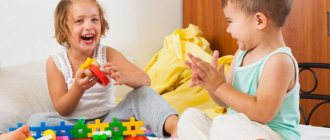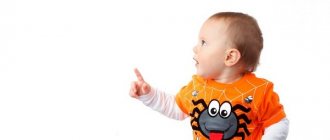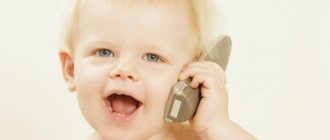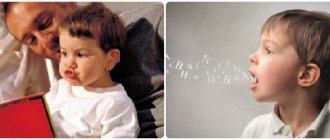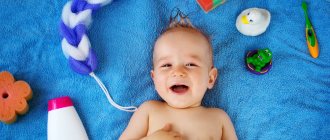The average height of a 4 year old child is 108-110 centimeters. However, height at 4 years can be slightly less than 100 centimeters, which depends on the genetics and development of the child.
Child 4 years old and his height photo:
What to do with a 4 year old child at home
Developmental games for children 4-5 years old:
Preschoolers love to use props. Sticks become swords. Blankets transform into super hero capes. At four years old, your child's imagination is in hyperdrive. She can become whatever she chooses - a doctor, a mother or a pilot. Her imagination creates longer, more complex dramas in which others can participate, so play scenes can last many hours or be repeated over several days.
Conversations can sometimes feel like interrogations: where are we going, mom? When will we get there? Who will we see? Why won't dad come with us? She begins to understand that there are reasons for things - and she wants to know what they are.
Another reason for constant questions is that your child's vocabulary is exploding and she wants to practice using words to explore her world.
External data
After 4 years, visible changes in external data appear; during this period, active development of bone and muscle tissue occurs. Remember that at this age the skeleton is still flexible, make sure that the baby does not sit in the wrong position for a long time, does not overload, and sleeps on a medium-hard mattress. During this period, the center of gravity of the body shifts, its proportions change, and childhood swelling disappears from the face.
Height and weight
By the age of 4, there is an increase in weight (1.8-2.2 kg) and height (5-7 cm). To monitor the correct development of children, there are special tables with which weight and height are checked. They provide data separately for boys and girls.
If there are slight deviations, this is not a big deal, all recommendations are average, and each person is individual.
Table: average height and weight for children 4 years old.
| Index | Boys | Girls |
| Weight, kg | 12,7-21,2 | 12,3-21,5 |
| Height, cm | 94,9-111,7 | 94,1-111,3 |
Now there are online calculators with which you can quickly check whether a child’s development meets the standards adopted by the World Health Organization (WHO).
Attention and perseverance
Interesting and educational tasks for children 4-5 years old: Some four-year-old children spend significantly more time with games and puzzles than a year ago. They come out of their game less often and may become so engrossed that you have to interrupt them.
The average attention span of a four-year-old is still between five and ten minutes. That may not seem like much, but compare that to three or four minutes a year or two ago. Keep these numbers in mind when planning projects or group events such as birthday parties. Even if your child can play a game for half an hour, on average you should expect less.
Child's character:
Basic rules of the game
There are several important rules when organizing leisure and educational activities with a child, by following which parents can get good results by raising well-rounded, creative and intelligent children, who are also in excellent physical shape:
- It should be remembered that it is better to conduct all educational lessons with the child in the first half of the day, when he is full of strength, energy and has a positive attitude;
- the emotional state of children is very important, since in a good mood they have better contact with adults and their peers, grasp the nuances of the game much faster, and are more open to accepting new information;
- any training should be carried out in the form of gameplay and carry a useful charge;
- It is better to plan games and activities in advance; it is also advisable to create the right atmosphere, and for this you will have to prepare various aids, materials or attributes.
Adults should think through all these things in advance. Psychologists advise fathers and mothers to draw up far-reaching programs for the week, or even a month in advance - the child’s achievements will depend on this.
If a place for outdoor games is being prepared at home, care must be taken to remove all fragile and breakable objects; it is better to cover the sharp corners of the furniture with soft material to avoid injury. This is especially true if friends come to visit your son or daughter.
Knowing what to do with a 4-year-old child at home, of course, we must not forget that you need to alternate mental activity with active pastime - this way, excessive tension is relieved and the kids get less tired.
Character of a child at 4 years old
Why is my child aggressive?
This is just a normal stage. It's frustrating if your preschooler hits, bites, or kicks, but his behavior will likely improve over time. He or she just needs to grow up.
You can help him by knowing what might trigger his anger. Your child is more likely to act aggressively when he is tired, or when he feels hungry, thirsty, or generally out of sorts. For example, you may notice that she tends to act aggressive at the end of a long day of shopping or before lunch.
Keep a daily routine
Make sure your baby gets food when she's hungry and rests when she's tired. If possible, you can also avoid times and places where you know she might have trouble staying calm.
Aggression may also occur if your preschooler is feeling overwhelmed or upset, or when he is in an unfamiliar situation, such as opening a daycare. She may act aggressively if she cannot find the words to express her strong feelings.
In some cases, aggression can be a means of attracting attention. If your child gets a big reaction from you when he acts aggressively, he will soon realize that this is a good way to get you to pay attention to him.
Almost all young children behave aggressively from time to time, and some go through longer phases of aggression. Your child's aggression will likely decrease as his social and language skills mature.
Fine motor skills
The development of a 5-year-old child also provides for a certain level of graphic skills: The child knows how to use various drawing tools (crayons, felt-tip pens, pencils). Children should be able to draw lines, circles, simple objects, outline, and color. Free materials on our website for the development of fine motor skills in a child:
- Stroke by points
- Large size coloring pages
- Coloring pages of flowers, dinosaurs, horses, fish and others.
When should I be concerned about my child's aggression?
Your child will likely grow out of her aggression on her own as she gets older, without any additional help.
Sometimes aggression can be a sign of an undiagnosed learning disability or emotional problem. Ask your GP if your child's aggressive behavior:
- happens every day or most days
- is serious, and may cause harm or damage to her, others, pets or property
- becomes more frequent or severe as she gets older
- involves aggression towards oneself, such as slapping or scratching oneself, or talking negatively about oneself
Nutrition for four year olds
A balanced and nutritious diet is of great importance. At this age, you need to eat every 3-4 hours, i.e. 4 times. The calorie content of food is within 1700 kcal.
The diet should include vegetables, fruits, cereals, soups and water (about 0.5 l). Sweets are given to a minimum (1-2 times a week). They get used to new food gradually.
Food is distributed as follows:
- breakfast and dinner 25% each;
- lunch - 30-35%;
- afternoon snack - 15-20%.
Vegetables and fruits must be present in a child’s diet.
Developmental activities for children 3 - 4 years old “Logic”
Author I. Bushmeleva. Artist N. Gubareva.
Children 3-4 years old are already able to group objects based on the main feature. The lesson is based on a small number of groups that a child constantly encounters in everyday life.
Task for the child: show where the clothes are drawn in the picture. Now look, what do the remaining items have in common? The child must not only show objects from one group, but also name this group (furniture, dishes, transport).
This activity is aimed at the child establishing a logical connection between “paired” objects.
Assignment for the child: choose a pair for each item you see in the picture.
Lesson with a 3-4 year old child “Question and answer”. Ask questions only if your child is interested in answering them.
Task for a child: complete the phrase I say or answer the question.
- When they eat, they take a spoon, and when they drink, they take...
- It's dark at night, and in the morning...
- The bird flies, and the fish...
- An airplane flies across the sky, and a boat sails across...
- If the traffic light is red, you need to stand, and if it’s green...
- Pants and a jacket are clothes, but soup and porridge...
- People have arms and legs, but cats...
- Honey is sweet, and lemon...
- The butterfly flies, and the grasshopper...
- The duck has a lot of ducklings, and the chicken...
Children aged 3-4 years old often create fantasies using their imagination. Let's add logic to it. It’s good if the child explains why he thought one way or another (for example, a dog tells a funny story because he smiles).
Activity with a child: Tell me what the animals talk about? Who is the cat talking to and what do you think, why? What did the magpie say? etc.
This is an activity for children aged 3-4 years to develop attention.
Assignment for the child:
- Compare the objects in the picture and choose the extra object in each row, explain your choice (for example, all the cups are striped, one with circles, or all the Christmas trees have one half yellow and one half is not).
- Find in each row exactly the same object as the first. (1=4, 1= 3, 1=4, 1=2).
A child of 3-4 years old should already understand which items of clothing are intended for what, even if he himself does not yet know how to dress
It is important that the clothing items are “put on” in order (i.e. socks first, boots second). In this case, the baby must say what this or that item of clothing is called.
Assignment for the child: the girl Katya was getting ready to go out for a walk. It's cold outside today. Help Katya get dressed so she doesn't freeze.
Classes for a 3-4 year old child to strengthen eating skills.
Task for the child: Vasya wants to eat. Help him do everything right.
1. How should you pour soup into a plate? (with a ladle)
2. What do you eat soup with? (with a spoon)
3. Fried potatoes in a frying pan. What should Vasya put it in and what will he eat it with? (on a plate, with a fork)
4. Vasya is thirsty. What will he pour the tea into? (in a mug, glass)
5. The boy likes his tea to be sweet. What does he need to do for this? (put sugar in tea and stir with a spoon)
6. Vasya ate deliciously. What will he tell his mother? (Thank you)
7. What should you do with the dishes after dinner? (wash, wash the dishes) Will Vasya help mom? (Yes, sure)
Assignment for a child: show and tell who lives where.
Lesson for children 3-4 years old “What’s more”
Task for a child: look at the picture, which fish is bigger? Which dog is smaller? etc.
What types of activities can you do at home?
At home, the child can be occupied with the following:
- Children aged three and four years old love to reproduce the world around them on paper. Prepare pencils or markers for drawing with your child. Discuss what he wants to draw, ask what color the objects will be in his drawing. Give him large sheets of paper or even a piece of scrap wallpaper. The scale will captivate your little one, and he will be busy for a long time.
- Before giving him pencils, invite him to use a sharpener - he will then be more enthusiastic about drawing.
- You can keep your child busy playing with a hole punch. Show how a hole punch works, let it make confetti for the New Year holidays from old magazines.
- Cutting with scissors is also fun for kids. By the age of four, children can cut out simple figures. Make stencils of geometric shapes. Let him cut it out. And then build an applique with it.
- You can give your child stencils of various objects (available on sale, or you can make them yourself from cardboard) or letters. The child traces the stencil and then paints it.
- It is difficult to force children to sculpt from plasticine alone. Roll him a lot of sausages - let him cut them into pieces, and then lay out the pattern on a sheet of cardboard.
- Stretch a string, give clothespins and let him hang his things and then collect them.
- Children are fascinated by working with carbon paper. Show him the technology of work. Rest assured that your child will engage in work with interest.
- Kinetic sand will help parents out; children will love this activity.
- You can buy stickers for children and give them an album - the child will stick until he uses all the stickers.
- You can also keep children busy by drawing with dots. Download such pictures from the Internet.
- Children may be interested in the magnifying glass. Give him small pictures and let him look at them with a magnifying glass.
- There is an interesting invention - puzzles. Choose sets for your baby according to age and interests. He will be studying for a very long time, rest assured.
There is another interesting activity: take large beans, pasta and some peas, move them and instruct your child to sort them into three containers. Play it as the help you need around the house. Be sure to praise.
In general, the kitchen attracts both girls and boys - use your imagination, and your little helper will be happy to complete tasks.
Children will be happy to help in the kitchen
Self-care skills
The level of development of a child 4-5 years of age also provides for certain everyday skills. They are determined largely by the psychology of parents, upbringing, and the behavior of adults in everyday life: the baby needs to be taught to take care of himself. The most important skills are:
- Ability to dress independently, fasten buttons and zippers.
- Tie shoelaces.
- Use a fork and spoon.
The child knows the main difference between berries and vegetables and can tell when they grow. Identifies the main types of animals and knows their differences.
